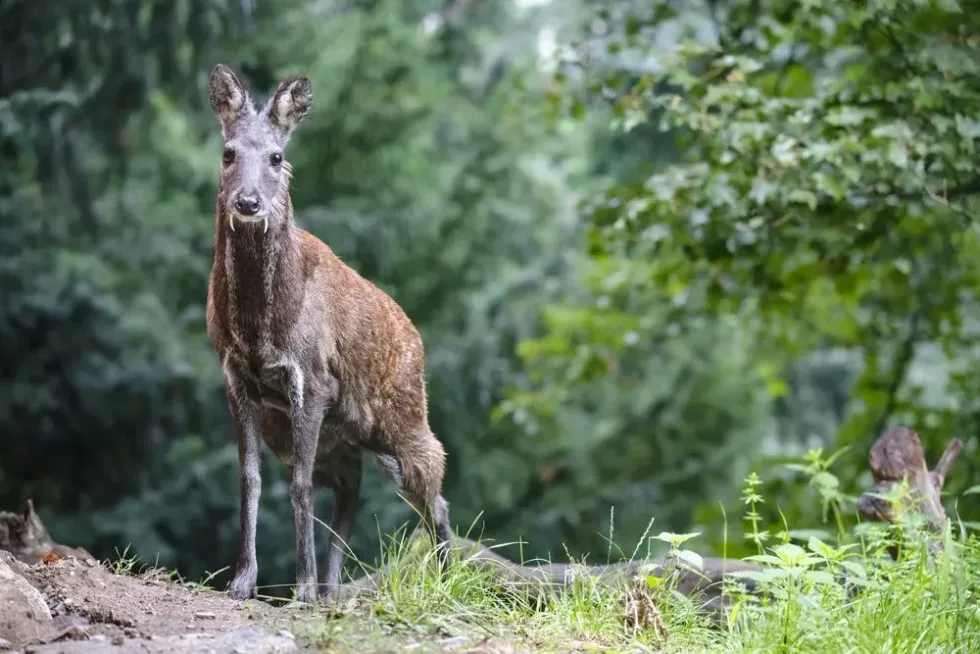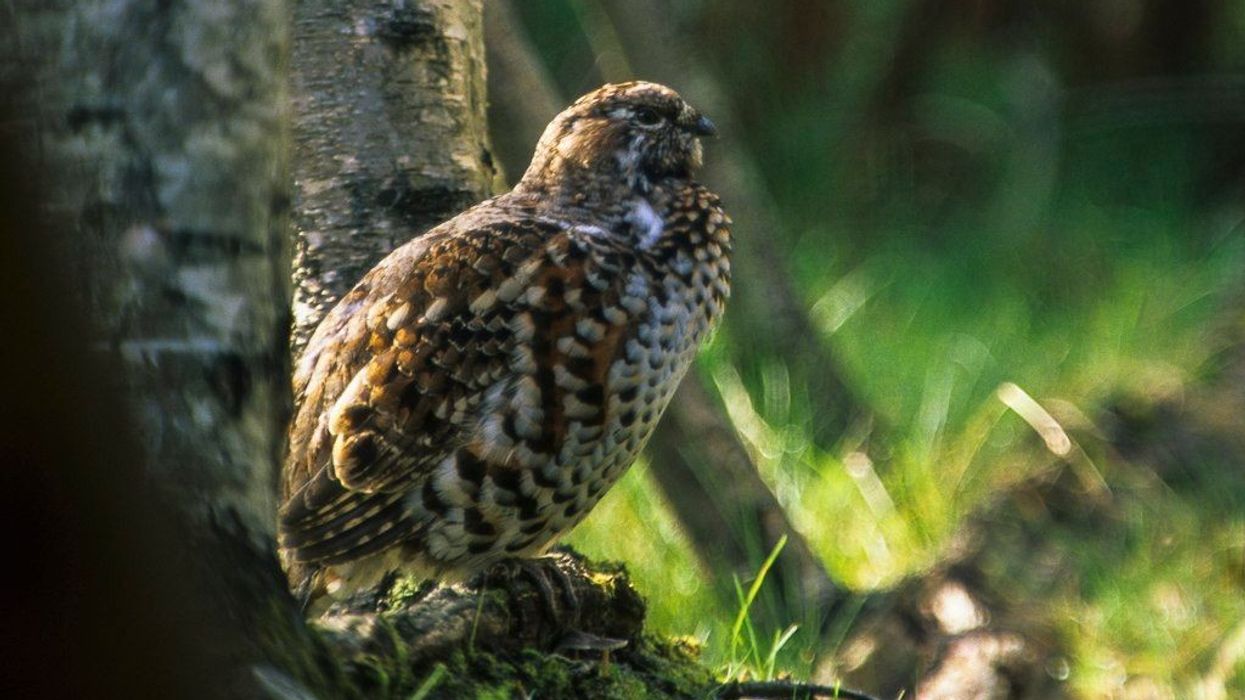The Alpine Musk Deer (Moschus chrysogaster) is a near-threatened ruminant species with a distribution range across the Himalayas of Asia in Bhutan, China, India, Afghanistan, Pakistan, and Nepal. They belong to the family Moschidae which is part of a clad that includes Cervidae and Bovidae.
This musk deer has two subspecies which are native to specific regions of the Himalayas.
This Musk Deer species has unique characteristics such as its upper canines protrude outside the mouth with a small red-brown body and small tuft-like tail. This species habitat includes the deciduous or coniferous forest with fir or oak trees, mountain caves, and shrubs.
The diet of this species is herbivores and includes food such as moss, lichens, shoots, forbs, leaves, and twigs. The mating season of this musk deer is observed during late November, and the young are born between June and July.
Considering these musk deer are solitary, there is a lack of extensive research about this species. According to ecology reports, it is known that along with natural predators in the wild, illegal poaching is a threat to this musk deer population. As a result, for the Alpine Musk Deer, IUCN has declared the conservation status Endangered.
If you want to know more about other ruminants, check out the Chinese Water Deer and Axis Deer.
Alpine Musk Deer Interesting Facts
What type of animal is an Alpine Musk Deer?
The Alpine Musk Deer (Moschus chrysogaster) is ruminant from the genus Moschus.
What class of animal does the Alpine Musk Deer belong to?
This musk deer belong to the class of Mammalia under the Family Moschus and Family Moschidae. Along with the two mentioned above, this family comprises a clade with Ruminantia, which is part of the order Artiodactyla.
How many Alpine Musk Deer are there in the world?
The current population range of these musk deer is unknown because it is quite a task to research this solitary species. However, some reports suggest that their population was around 180,000 mature individuals in the '60s and '70s, with around 100,000 mature individuals in China during the '90s.
Where does the Alpine Musk Deer live?
These musk deer's geographic range is observed across the Himalayas in China, India, Bhutan, Nepal, Afghanistan, and Pakistan. The M. c. chrysogaster subspecies are found in Himachal Pradesh, Sikkim, Uttarakhand, Tibet, and some Bhutanese regions. The M. c. sifanicus has been spotted in west Sichuan, Yunnan, Qinghai, Ningxia, and Gansu.
What is an Alpine Musk Deer's habitat?
The Alpine Musk Deer habitat is found in the mixed coniferous or deciduous forest, especially with oak or fir trees. They are found at a high altitude range between 7,217.8-14,107.6 ft (2,200-4,300 m), with rare sightings below 3,280.8 ft (1000 m).
This musk deer species inhabit mountain ranges with moderate to steep slopes with various other plants such as juniper, birch, blue pine, rhododendron, lichens, grass, and shrubs.
Who does the Alpine Musk Deer live with?
According to various observations, these musk deer are solitary in nature and are highly territorial. However, the males' territories may share common regions with the multiple female territories.
In addition, they can communicate with each other due to their characteristic scent gland by rubbing the caudal gland against plants, leaving a mark. They do not migrate and all the musk deer within a specific distribution range tend to use the same spot for defecating or urinating.
How long does an Alpine Musk Deer live?
The Alpine Musk Deer (Moschus chrysogaster) have an average lifespan of around 8-10 years. These deer live for around two to four years in captivity, but the highest recorded lifespan in captivity is 17 years.
How do they reproduce?
These musk deer are sexually mature at the age and can track their mate based on the scents left behind with the caudal gland, while males also release musk in their urine.
The mating season of this species is seen from November to January, with a shorter gestation period of 180 - 200 days as compared to that of a True deer. A doe gives birth to one fawn or twins in each cycle, usually between May and June.
Fawns usually stay hidden for about two months after birth and wean after a couple of months, but they stay with the mother for around two months before heading off on their own.
What is their conservation status?
This musk deer population distribution is threatened due to poaching and trade, especially in the Himalayas. As a result, the IUCN has given this species the Endangered conservation status.
Alpine Musk Deer Fun Facts
What does the Alpine Musk Deer look like?
This musk deer has the body of a small deer with prominent fang-like top canines that protrude outside the mouth. They have pointy, white-lined, rabbit-like ears, a black snout, a short tail with tiny tufts, and a brownish-red fur coat.
In addition, these musk deer have a caudal gland at the base of their tail, which is used to leave scents.
 *We've been unable to source an image of an Alpine Musk Deer and have used an image of a Siberian Musk Deer instead. If you are able to provide us with a royalty-free image of Alpine Musk Deer, we would be happy to credit you. Please contact us at hello@kidadl.com
*We've been unable to source an image of an Alpine Musk Deer and have used an image of a Siberian Musk Deer instead. If you are able to provide us with a royalty-free image of Alpine Musk Deer, we would be happy to credit you. Please contact us at hello@kidadl.com
How cute are they?
These musk deer have a normal deer-like appearance, except the fang-like protruding canines. Apart from those, this musk deer looks quite adorable.
How do they communicate?
These musk deer do not make specific sounds to communicate. Instead, a peculiar behavior, especially among males, is noticed. They leave their scent in forests via the caudal gland situated at the base of their tail. They rub it against plants, leaving a brown, waxy smear that allows other musk deer to locate or communicate with them.
How big is the Alpine Musk Deer?
These musk deer are around 39.4 in (100 cm) in length and 15.7-23.6 in (40-60 cm) tall. This species is around the same length as the White-tailed Deer.
How fast can an Alpine Musk Deer run?
Due to the lack of observation, the speed at which these musk deer run is unknown. However, their long hind legs allow them to take broad leaps, making them agile jumpers. These musk deer can take a 19-feet leap and change directions swiftly.
How much does an Alpine Musk Deer weigh?
These musk deer are rather small ruminants and weigh around 22-33 lb (10-15 kg) which is around half the weight of the Key Deer.
What are the male and female names of the species?
The female is known as a doe, but whether the males are called stags is unknown.
What would you call a baby Alpine Musk Deer?
The young of these musk deer are called fawns.
What do they eat?
These musk deer have a herbivorous diet and their food consist of at least 13 different plant species found in a coniferous or deciduous forest. Some of the food they eat includes leaves, flowers, buds, forbs, grasses, lichens, coniferous needles, and plant shoots.
They also feed on barks of trees such as honeysuckle, aspen, willow, mountain ash, bird cherry, and aspen.
Are they dangerous?
These musk deer are shy and keep away from other animals. They can be highly territorial and even bellow or hiss when threatened or injured. Apart from this, these musk deer do not show any aggressive behavior in captivity or the forest.
Would they make a good pet?
These musk deer are wild animals that live in dense high-altitude forests of the Himalayas, and that is why they would not be ideal pets.
Did you know...
Some of these musk deer predators include snow leopards, yellow-throated martens, lynx, foxes, and wolves.
Although native, these musk deer are considered separate species from the Himalayan Musk Deer, the Siberian Musk Deer, and the Black Musk Deer.
These musk deer protect themselves from predators by climbing trees and disappearing into the dense forests.
What is Musk Deer killed for?
These musk deer are poached popularly for their highly-valued musk gland. This musk is known to have specific pharmaceutical and cosmetic properties, increasing their international demand through illegal means as well. These glands are extracted directly from the live animals by poachers known as 'musk-gatherers.'
What is the special feature of Musk Deer?
The most special feature of these musk deer is their musk-producing sac that sells at high values in the international market. In addition, these musk deer stand out because of their smaller bodies and fang-like top canines that hand outside their mouths.
Here at Kidadl, we have carefully created lots of interesting family-friendly animal facts for everyone to discover! For more relatable content, check out these Fallow Deer facts and Black-tailed Deer facts pages.
You can even occupy yourself at home by coloring in one of our free printable deer coloring pages.
*We've been unable to source an image of an Alpine Musk Deer and have used an image of a Siberian Musk Deer instead in the main image. If you are able to provide us with a royalty-free image of Alpine Musk Deer, we would be happy to credit you. Please contact us at hello@kidadl.com




 *We've been unable to source an image of an Alpine Musk Deer and have used an image of a Siberian Musk Deer instead. If you are able to provide us with a royalty-free image of Alpine Musk Deer, we would be happy to credit you. Please contact us at hello@kidadl.com
*We've been unable to source an image of an Alpine Musk Deer and have used an image of a Siberian Musk Deer instead. If you are able to provide us with a royalty-free image of Alpine Musk Deer, we would be happy to credit you. Please contact us at hello@kidadl.com



